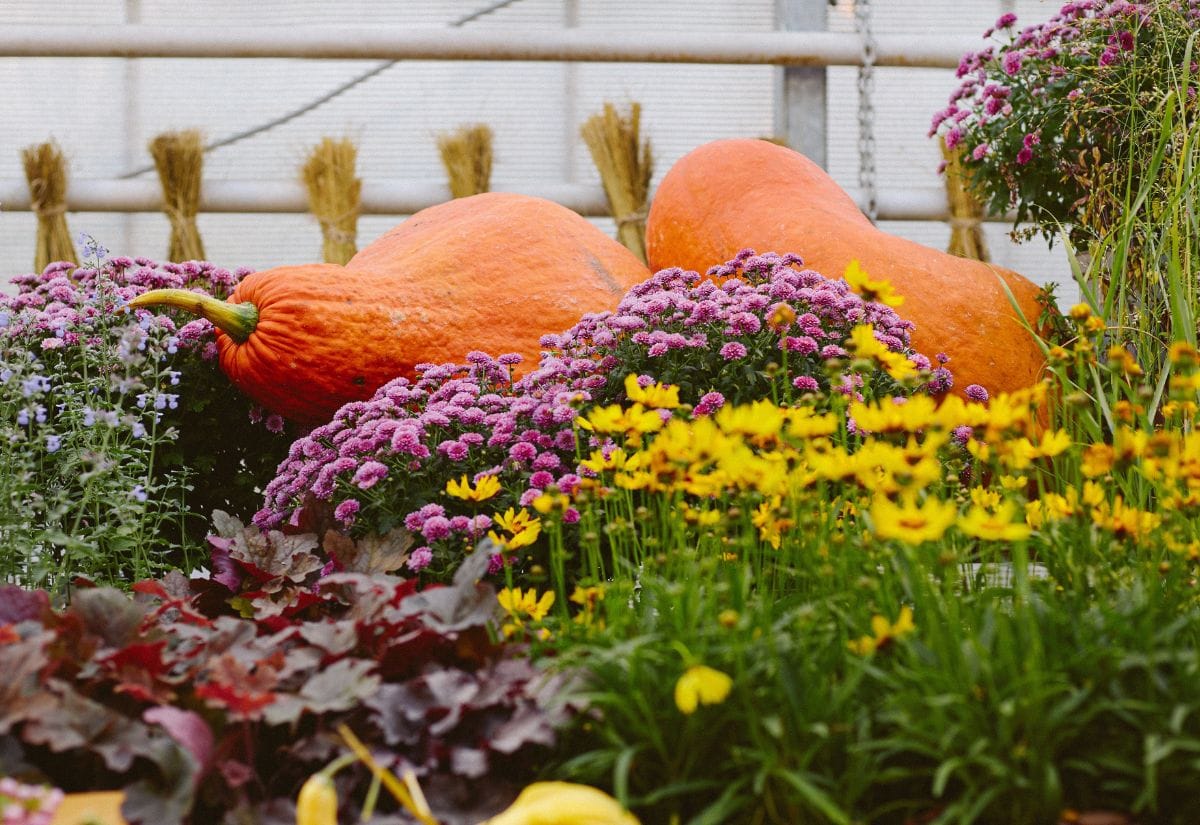
Whether your garden is a large country plot or a group of containers on a city balcony, plant easy-to-grow flowers that looks lovely to your fall window boxes, containers, and flower pots.
Dubbed as the “season of mists and mellow fruitfulness,” fall, or autumn, isn’t just a precursor to winter, but a period where bright blooms can enliven your space. Even without a garden, your autumn can be colorful with fall-flowering plants that thrive in pots and containers.
As leaves adopt a coppery hue and berries mature, flowers too, embrace warm and rich shades, reflecting the autumnal melancholy and contemplative nostalgia.
Though planting in full soil often facilitates the growth of fall blossoming flowers, a considerable variety like violas, colchicum, orchid lilies, cyclamens, and dahlias flourish well in fall flower pots too.
So, don’t allow the dip in temperature to deter you from assembling lovely fall planters this season. In this article, I’ll guide you through some of the finest fall flowers suitable for pots and containers, enabling your balcony, patio, terrace or window box to retain that last warm essence of life before winter sets in.
And I’ll do it with tips on how to grow fall containers plants, make best use of them and great pictures as well.
Now, let’s delve into discovering them one by one…
15 Spectacular Fall Flowers For Pots and Containers
So, as you set out to infuse the essence of fall into your space, remember, a rich palette of autumnal blooms awaits. All it takes is a few pots, a dash of patience, and an undying love for the season’s spell.
From dahlias to cyclamen, colchicums, asters, and black-eyed Susans, here are 15 of my favorite fall-blooming for pots, ready to bring a kaleidoscope of autumnal colors to your container garden.
1. Dahlias (Dahlia spp.)
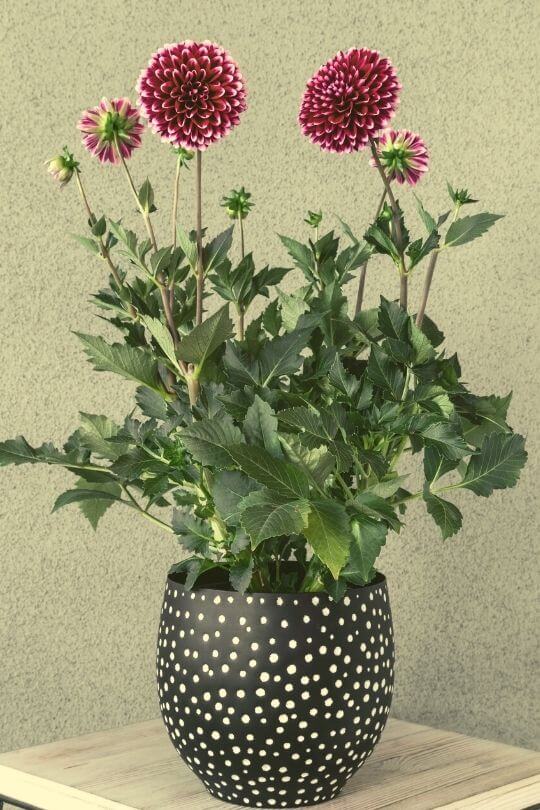
Dahlias come to mind immediately when we think about fall; they are, in a way some of the most iconic autumnal flowers perfect for container planting.
Their warm and rich colors, most typically in the orange to purple range, are so in tune with the late season, each recreating a small sunset in your garden, and their round and full shapes add to the mellow wistfulness of this time of the year.
With generous, large and showy blooms that usually start in mid summer but keep going till the first frost, dahlias are common in beds and borders, but you can easily and successfully grow them in containers as well.
There are many varieties and cultivars that harness the mood of this season, like ‘Bantling’ with large coral and globular flowers, ‘Coballero’, with very regular red petals with a yellow edge, the intense dark purple ‘Chat Noir’ or the aptly named ‘Hart’s Autumn Splendor’, with long and curled petals that shade from bright orange to yellow, a bit like the Sun before setting.
2. China Aster (Callistephus Chinensis)
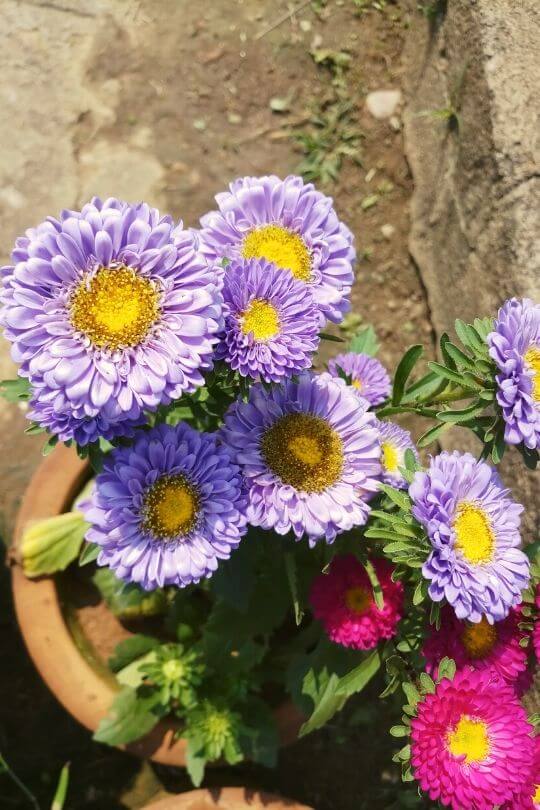
Maybe you want a display of vibrant energy before the cold season comes to bring life and light to your pots, containers and window boxes?
China aster will give you that “humph” with upright stems bearing many round, multi-petaled daisy like flowers with hues that range from magenta pink to violet blue, but all with a yellow disk inside.
This annual plant too has a very long blooming season; in fact it will keep coloring your pots for the whole of summer and then fall, and it is very easy to grow from seed, as well as low maintenance and pretty hardy indeed.
It is, in fact, a very safe choice if you do not have the green thumb or if you live in a fairly cold place.
3. Sweet Autumn Clematis (Clematis Paniculata)
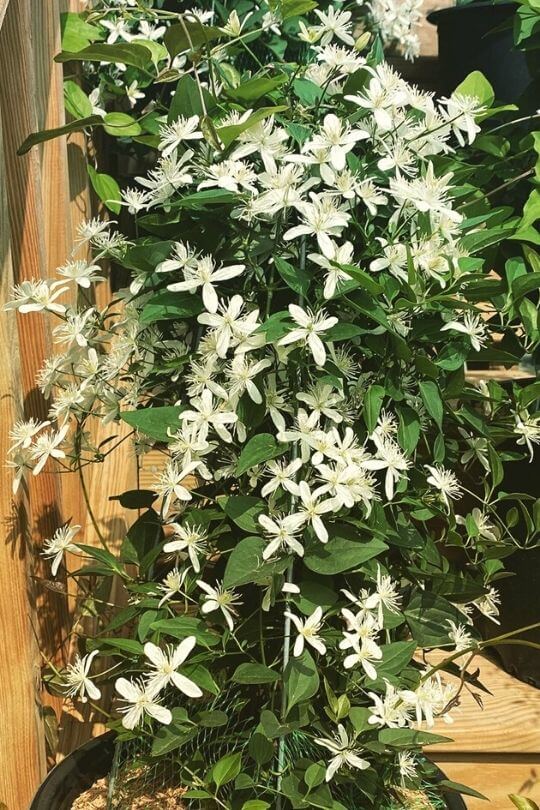
If you have a large container or pot and you want sizable perennial that puts on an impressive display from late summer through fall, sweet autumn clematis will not disappoint you.
In fact, every year, as the warm season draws to a close, this clematis will cover in a multitude of showy large flowers with bright yellow centers that look like doves in the wind, or butterflies resting on thin and dark stems.
In a way, this flowering beauty contrasts the season’s mood, with its springtime feel and look and sweet fragrance and, while it is often grown in full soil, it will easily adapt to large containers and it is perfect for patios and terraces.
4. Violets And Pansies (Viola Spp.)
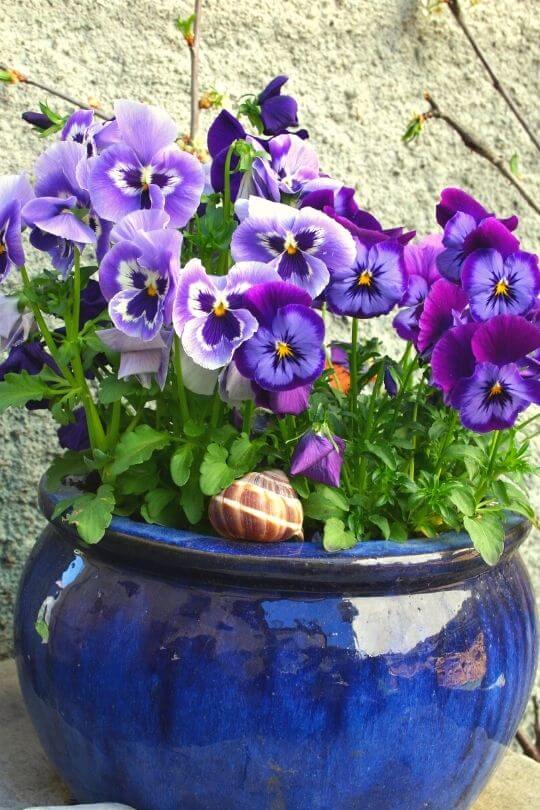
Violets and pansies are heroic bloomers, starting in spring and nit giving up till the first frost in most cases.
While violets will tend to last longer in many cases, both are good companions to keep in even small or shallow pots when the Sun’s rays start lowering on the horizon…
The array of colors they offer is beyond belief, offering autumnal colors like copper or garnet while keeping also blue, white and violet shades.
The combinations are just impressive and, as they are easy to get and even easier to grow, these lively flowers are a safe choice for window boxes and small pots.
5. Toad Lily (Tricyrtis Spp.)
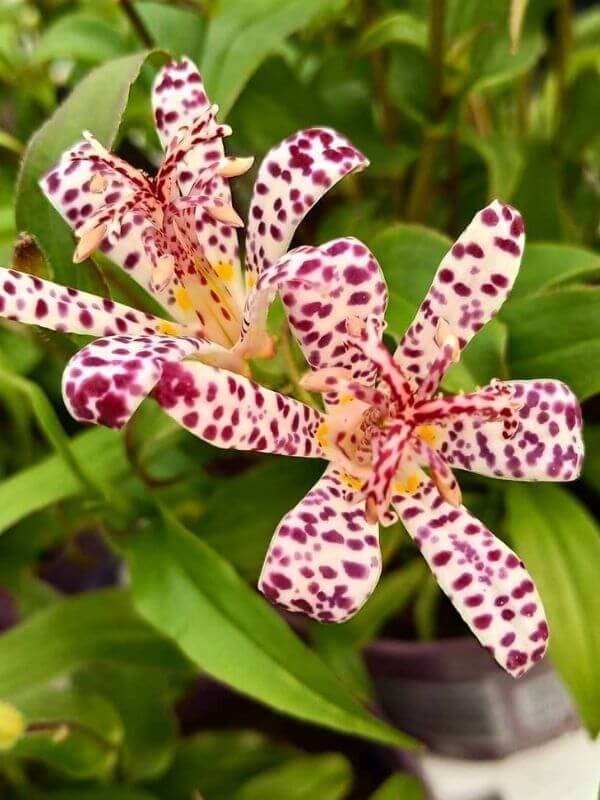
Also called orchid lily, for the exotic shape and coloring of its flowers, this perennial is a wonderful presence during fall, with its very unusual waxy flowers, often white or off white pink with magenta and purple dots that look a bit like marine creatures, or, to some, psychedelic toads from another planet.
There are also variety with yellow petals and orange dots (Tricyrtis latifolia) and other combinations, like violet and white, violet and yellow, pink and yellow and some (Tricyrtis formosa) with larger petals too.
Very playful companions on late summer and fall afternoons when they pick up the transience of the season with their mystifying display of expressive colors and their rebellious shape, toad lilies are excellent in borders and beds, but they are also great in patio gardens, containers and on terraces.
Play with the dappled pattern of the flowers by growing them in dappled shade if you want, and the effect will be spectacular.
6. ‘Garden Angel Bush’ Begonia (Begonia ‘Garden Angel Bush’)
Most begonias flower in summer, but ‘Garden Angel Bush’ (also called angel wing begonia) is beyond belief: it will bloom repeatedly throughout the year, including fall and even winter.
But that’s not all. While the flowers are not particularly showy, the four pink petals being fairly small, and coming in little groups above the foliage, the leaves are a spectacle as well!
Large and palmate, they are silver with large, decorative dark green purplish veins when mature, but new leaves are of a rich magenta color with very dark, almost black veins!
7. Chrysanthemum (Chrysanthemum Spp.)
The national flower of Japan, chrysanthemum, is arguably the most iconic fall flower in the world. While for market reasons it has long been associated with graveyards in the West (it blooms around All Saint’s Day), it is now having a revival with its bounty of flowers as in pots and containers for purely decorative reasons.
Chrysanthemums are photoperiodic plants, which means that they blossom when the ratio of daylight and darkness is correct, in this case, 16 hours of darkness and 8 of light (or at least less than 10), which is, you guessed, what happens in fall.
There are impressively beautiful varieties and cultivars you can choose from, like ‘Fireglow Bronze’, whose name gives you a perfect description, ‘Cheryl Pink’, with a globular flower of perfectly placed ultra pink petals, or the stunning ‘Matchsticks’, which has tubular yellow petals that show a red drop at the tips…
8. Autumn Crocus (Colchicum Spp.)
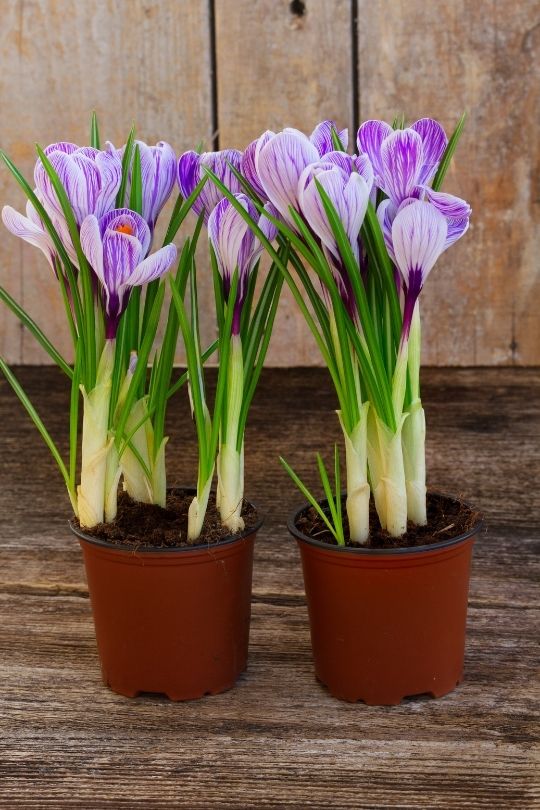
It is not actually a crocus, and they are not even closely related (only at clade level), but colchicum (or autumn crocus) really looks like the larger brother of the famous spring flower.
This beautiful bulbous plant has always fascinated me because the leaves will come out in spring, but the flowers come on their own in fall…
Much bigger than crocuses, they are mainly in the lavender to magenta range when it comes to color, at times with white centers.
But there a few varieties you can choose from, like the wildly looking Colchicum agrippinum, with the most amazing pattern of magenta dots on its petals, meadow saffron (Colchicum ‘Waterlily’) with double flowers that look like or Colchicum speciosum ‘Album’, which is totally white.
9. Cockscomb (Celosia Spp.)
Your terrace can fill with upright plumes of the brightest red, purple, orange or yellow on top of light green leaves that grow horizontally if you plant cockscomb in your pots and containers.
Small enough to be suitable for window boxes as well, Celosia produces massive and long lasting inflorescences that is a banquet for pollinators for many months, including fall, when food for them tends to become scarce.
10. Black-Eyed Susan (Rubdeckia Spp.)

Few flowers can convey the autumnal light and colors like this coneflower: black-eyed Susan, so called because the central disk is dark (purple, brown or almost black), has petals that can range from yellow all the way to the deepest burgundy, and many varieties, like ‘Capuccino’, ‘Chicago Orange’, ‘Autumn Colors’ and ‘Summerina Orange’ dwell on and explore the copper and orange palette like few other flowers do…
Your heart will melt with the warmth and melancholy of these flowers when they fill your pots and containers like many autumnal setting suns waving you goodbye.
11. Japanese Anemone (Anemone Hupehensis ‘Hadspen Abundance’)
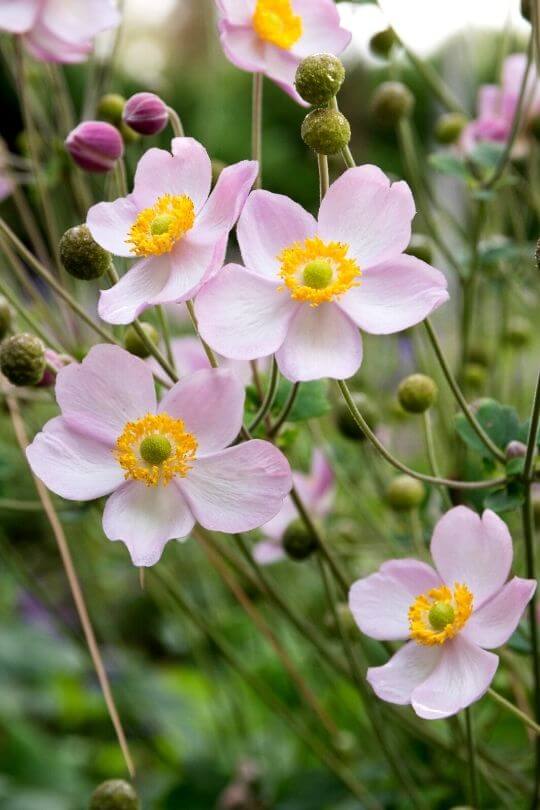
This late flowering anemone will start blooming in late summer and continue all through fall with its bright, simple but charming magenta flowers.
It is a very elegant plant, with the flower heads resting delicately on long and thin stems, and this has gained her the Award of Garden Merit by the Royal Horticultural Society.
It will need large enough containers, like a 12 to 14 inch pot or a 1 gallon container, as its radical system is fairly developed and it is more common for borders and flower beds in full soil, but as long as you do this, it will settle in perfectly well.
12. Sweet Alyssum (Lobularia Maritima)
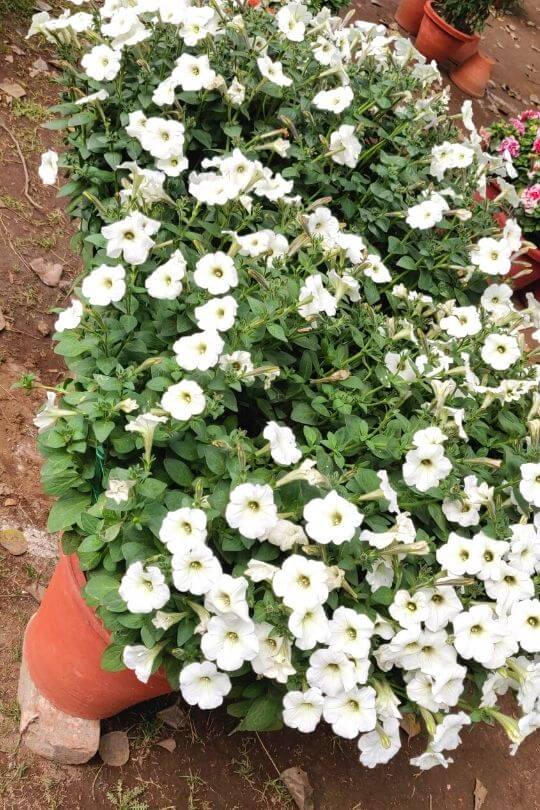
Sometimes fall blooms are not as profuse as spring ones; not with sweet alyssum though! This enchanting and generous flower with four rounded petals will create a blanket of snow white candor with yellow dots in the center of each head…
Maybe not autumnal in mood, sweet alyssum may offer you a fresh respite from the somber feeling that pervades this season and bring a positive, optimistic experience to your patio or terrace.
The variety ‘Snow Princess’ has received innumerable awards, if you want a “pedigree” plant in your pots.
13. Cilician Cyclamen (Cyclamen Cilicium)
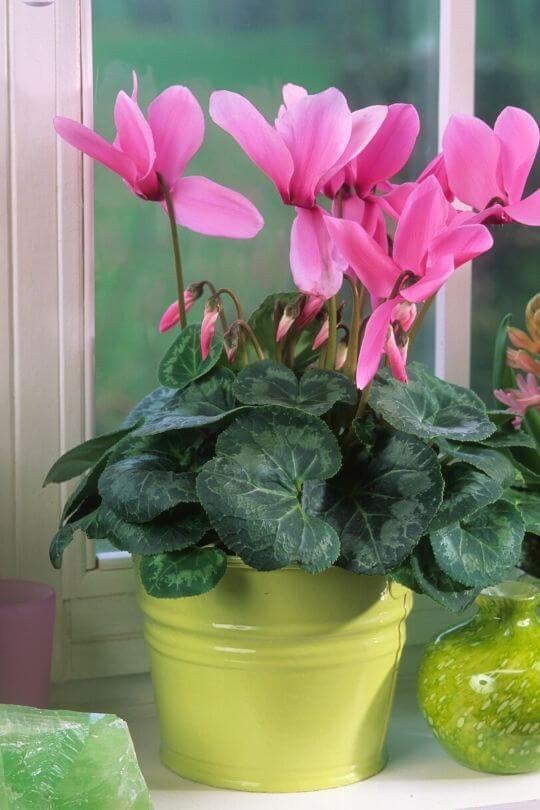
We could not forget cyclamens for your fall pots or containers… If you have had the luck of seeing the, blossom in woods, you know what an amazingly sweet spectacle they can put on.
Cilician cyclamen is a species with showy mauve or white flowers with a magenta spot in the middle, which can exceed an inch in diameter (2 to 3 cm).
Winner of the Award of Garden Merit by the Royal Horticultural Society, even the leaves of thus cyclamen are stunning and look like dark green hearts with silver veins.
14. Abyssinian Sword-Lily (Gladiolus Callianthus Murielae)
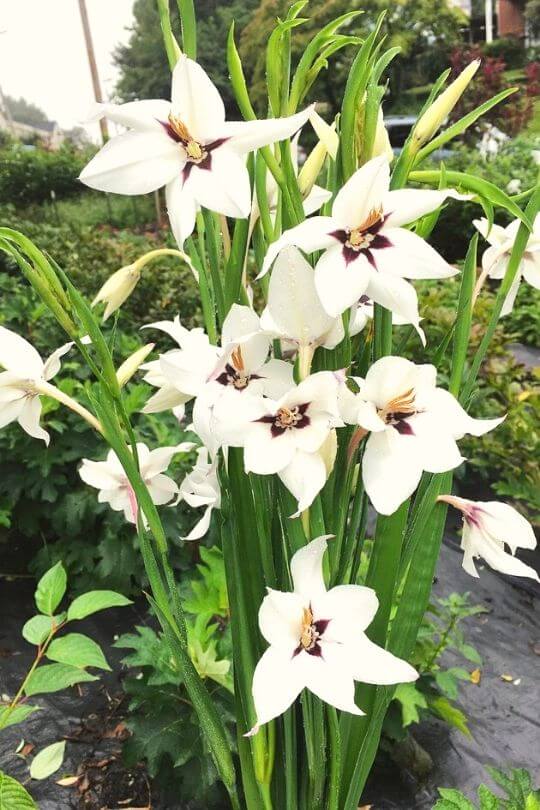
With six pointed petals that open like butterfly wings, white with a dark purple center, Abyssinian sword-lilies are oddly exotic looking and at the same time at ease in most other settings.
To me, they bring up images of panda bears, but whichever trick your imagination plays with your mind when faced with these elegant flowers, the effect they will have on your terrace or gracing your patio, with their artistic presence, can work both in informal settings or painting almost stylized pictures in an urban an even formal environment.
Plant about 15 corms in a 14 inch pot for best results with this RHS Award of Garden Merit winner.
15. Guernsey Lily (Nerine Bowdenii And Nerine Sarniensis)
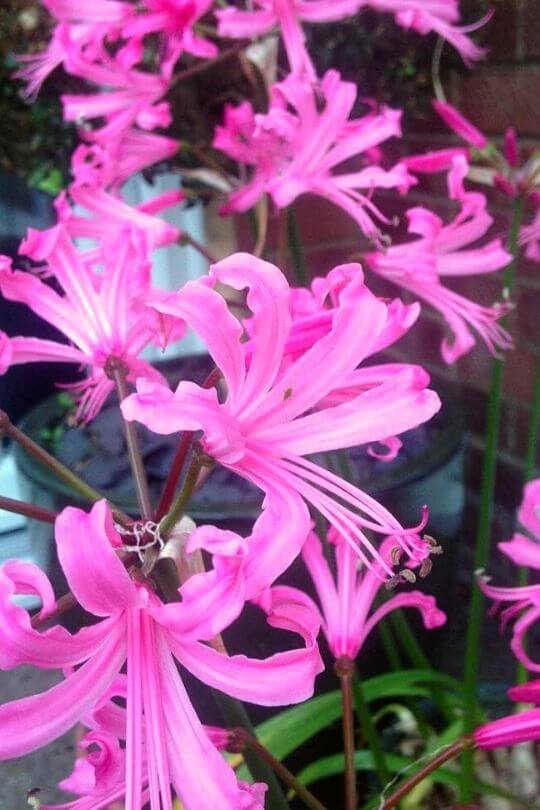
Guernsey lilies have six long and rebellious looking petals that surround pretty anthers, a bit like the “misfit cousins of lilies”, but, unlike their relatives, they will bloom from late summer into the autumn.
They are becoming common as fall flowers in beds and borders, but you can grow them in pots and containers too, and they will bring their dynamic originality to your terrace or patio.
There are some noteworthy varieties like the romantic looking ‘Albivetta’ with light rose petals, the flaming red and passionate Nerine sarniensis or the bright magenta pink Nerine bowdenii, which adds strap shaped leaves to the twisting petals, with dynamics worthy of the statue Laocoön and His Sons by Agesander of Rhodes.
Also Fall Can Have Pots “Twined with Flowers”, as Keats Said…
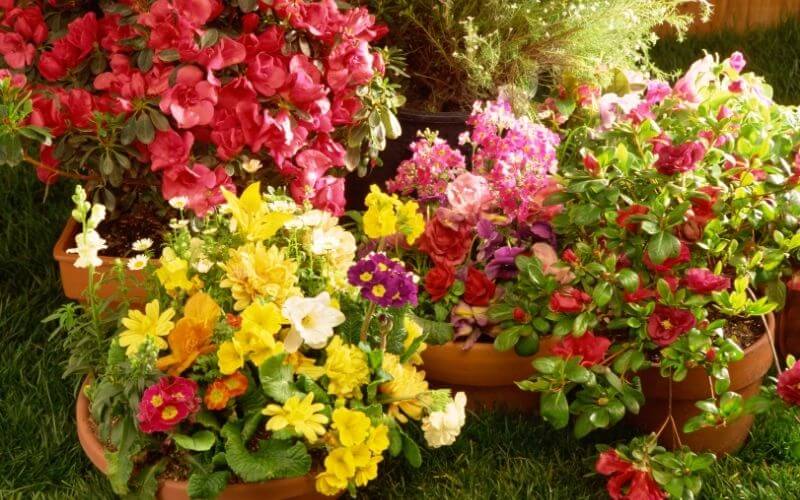
If you have come to this article because it is hard to find plants that flower in fall, especially for pots, containers and window boxes, you have my full understanding.
But as you can see, there are some really beautiful flowering plants that you can choose from, so your window box, terrace or patio can keep being beautiful, interesting, expressive and even dramatic till the first frost.
Fall does not need a “preparation for winter”, nor does it have to be an “extension of summer”,’especially a forced one…
Play with the colors of foliage and add some of the flowers we have just met and your palette and shaping can find your own expressive dimension of the feelings and meaning of this amazing season.

Written By
Adriano Bulla
After many years as an academic in London, Adriano Bulla became a writer, publishing books like A History of Gardening, Organic Gardening and Elements of Garden Design; he then decided to become a gardener, following his childhood dream, and has been following his dream writing and gardening professionally in Southern Europe, where he has specialized in new and innovative organic gardening fields and techniques, like permaculture, regenerative agriculture, food forests and hydroponics.
